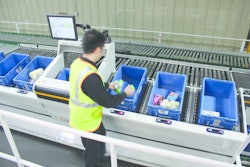
There is an ancient proverb that says it is better to light a single candle than curse the darkness. For the materials handling world, however, not only should we not curse the darkness, it may finally be time to embrace it.
The “lights out warehouse” has been talked about for years. So why hasn’t adoption of that concept taken off? After all, it sounds like a CFO’s dream—high productivity without all the ancillary costs and headaches that come with human workers.
There are many advantages to be gained by replacing people with machines from top to bottom in a warehouse or distribution center (DC) operation. Machines don’t require breaks or vacations, and you don’t need three machines doing the same thing to run three shifts. They don’t fatigue as they work or complain about how hard their jobs are.
Machines can be built to tolerate hotter ‘hots’ and colder ‘colds’ than humans, which enable significant energy and maintenance savings on heating and cooling in a distribution center. There is no federal agency protecting the health and welfare of machines, and they don’t require liability or health insurance; or yearly raises for that matter.
One other compelling reason is how it will protect a business against known and unknown competition. Ideally, every successful business wants to build a “moat”—an impenetrable barrier to entry that keeps others from cutting into their success. The large up-front cost for equipment and the sheer amount of knowledge and expertise required to run a lights out warehouse or DC create such a moat.
Think of it this way: If you want to open a lawn mowing business, all you really need to get started are a few mowers, people to run them and a means of transporting them. The barriers to entry are low, so ultimately the competition will be cutthroat. But, if you want to start a shipping business where the established leader already has a well designed, multi-million dollar facility and a great deal of expertise, you’ll probably think twice before deciding to compete in that arena.
Flipping the switch
So why hasn’t the industry flipped the switch on the lights out warehouse approach? There are a couple of issues holding it back. One, of course, is the difficulty in justifying the up-front cost of fully automating a warehouse or DC. While humans can be expensive over the long haul, you’re paying those costs in small, weekly or bi-weekly increments. Robots and automated equipment, on the other hand, have to be paid for up-front.
It can be difficult to get approval for that large of a capital expenditure, especially if the enterprise is focused on keeping costs down. But in an era where corporate finance departments are struggling to achieve two to three percent returns on their investments, automation can deliver annual returns in the 15 to 50 percent range, which makes it far more compelling to even the most financially cautious of organizations.
Another is the capabilities of the automated machines themselves. Traditionally, robots and other automation have been very effective at performing highly repetitive tasks. In manufacturing, for example, they’ve been excellent at putting the same screw into the same hole, or making the same weld, on product after product. But they haven’t been so good at dealing with variables. And what is a warehouse or DC if not an infinitely variable environment, especially in today’s fast moving e-commerce world?
The third is the risk factor. There aren’t too many truly lights out facilities of any type (much less a warehouse or DC specifically) to look at as a model for how it should be done. That’s a pretty risky proposition for any venture, much less one with such a high up-front cost. The cost of failure—in terms of lost business today, the loss of the lifetime value of customers and the expense of tearing it all out and doing something else if you do survive—is unpalatable to most organizations.
Yet, many still see the upside potential as huge. So, how do you decide whether to embrace the darkness by going lights out?
Here are a few factors to consider when working through the positives and negatives in order to come to a more informed decision:
Business Conditions. Start by evaluating your current business environment. Are you behind your industry? If so, by how much? Are you so far behind that not moving into (or at least down the path toward) a lights out approach will put the business in jeopardy? How are labor costs affecting you? Labor is one of the largest expenses in most businesses, so any sudden increases may make going lights out more attractive.
Obviously, your current financial state will have a bearing as well. If the business is thriving, or you are stable with strong cash reserves, it’s easier to justify the up-front expense involved with moving to a lights out operation.
Finally, you want to look at the stability of your market, and market conditions in general. Is it time for a bold move, or are you better off staying the course for now? If your industry is already changing—such as moving from a retail-only model to a goods-to-person or hybrid approach—you may have to make changes anyway. In that case, it’s worth considering a move to lights out.
Flexibility. Another aspect to look at is the amount of flexibility required for your day-to-day operations. As mentioned previously, automation works best with simple, repetitive tasks. While strides are being made to build more flexibility and problem-solving capabilities into machines, the industry still has a long way to go. Humans are still far superior at decision-making and adjusting to unplanned or non-standard events. At this point, the fewer variables you have, the better-suited your warehouse or DC will be for a lights out operation.
Seasonal Adjustments. The economics of automation are best realized when it is used 24x7x365. The seasonality of most retail operations, however, requires significant spikes in the workflow capabilities of the warehouse or DC at certain times. Supplementing the baseline automation capabilities with a seasonal manual operation is often an important part of a well-crafted automation plan. At the minimum, you need to consider the equipment required, the space for the equipment (and the people to work with it) and how these manual processes will be integrated into what is a fully automated operation the rest of the year.
All at Once or Small Bites? Legend has it that when Cortez reached the New World, he burned his ships behind him to show his crew that they were committed to the venture they were undertaking. That’s a fine symbolic gesture, but not necessarily appropriate for every business.
You need to decide whether business conditions dictate changing the whole operation all at once, or whether you can move into full automation a piece at a time. For the latter, you may want to start with installing or expanding some islands of automation to test the processes and see how they integrate with the rest of your operation.
Keep in mind, though, that even if you are opting for incremental moves you’ll want to put together a comprehensive plan and roadmap to get there. You need to be sure all the pieces will fit together seamlessly, and that they can be easily managed—preferably using a common interface that can be accessed over the Internet, since no one will be on-premise to react immediately to any problems. Which brings us to…
New Construction or Retrofit? Designing a brand new lights out facility offers many advantages. You can create the warehouse or distribution center specifically for its intended use—not just from a warehouse equipment standpoint, but also from the perspective of how typical building considerations such as lighting, heating/cooling, plumbing, etc. are incorporated. You don’t have to worry about creating safety zones for robotics, office space for supervisors, washrooms, lunchrooms or other amenities, so you will have the ability to maximize floor space. You can also run electrical power and computer networking more easily, which is good considering you will need more of both.
With a retrofit, of course, you have to work with what you have. Equipment has to fit into available space, and you may have to perform some extra work to get things such as power and network cabling everywhere it needs to be. You’ll want to plan carefully to make sure you understand the space and its requirements. While it’s always a good idea to create a simulation first to ensure that what looks good on paper works properly in reality, it is especially important when you are retrofitting new technology into an existing space.
Staff Expertise. Although the facility may run lights out under normal conditions, that doesn’t mean humans will be taken out of the equation completely. You will need some sort of staff to monitor the operation (either on-site or remotely) and troubleshoot any problems that arise. At least until the machines acquire enough intelligence to fix themselves, which is still a ways off.
With that in mind, you need to be sure you have a staff that understands how the machines operate and the supply chain outcomes you’re trying to achieve. Both aspects are important.
Expertise with the machines will help ensure they are running properly, that any potential problems are identified and corrected quickly, and that exceptions are handled in a timely manner. Expertise in the supply chain is also required, however, to help develop the larger picture and incorporate continuous operational change and improvement. Going lights out is about increasing efficiency, so the more you can learn and improve upon your original design the faster you’ll get to payback.
Lighting the candle
While the materials handling mainstream may still be a few years away from a true lights out facility, the candle has certainly been lit. Rather than cursing the darkness, warehouse and DC operations teams would be well-advised to embrace it by fully understanding the business conditions, processes and technologies that will turn a dark facility into a brighter day. It’s the best way to ensure your lights out strategy is a lights out winner.




















